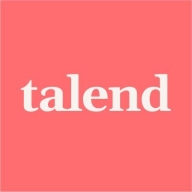

Talend Open Studio and IBM InfoSphere DataStage are prominent ETL solutions catering to different market needs. Talend Open Studio seems to have the upper hand for smaller enterprises due to its cost-effectiveness and ease of use, while IBM InfoSphere DataStage is preferred by larger enterprises for its robust features and performance.
Features: Talend Open Studio is noted for its user-friendly interface, advanced integration capabilities, and extensive range of connectors, which makes it accessible even to beginners. IBM InfoSphere DataStage offers high scalability, powerful ETL capabilities, and seamless integration with IBM's suite of tools, which benefits comprehensive data management projects.
Room for Improvement: Talend Open Studio could improve its enterprise features, installation configuration, and support for version control systems. Also, its documentation and support are areas users feel could be enriched. IBM InfoSphere DataStage users suggest enhancing cloud integration, pricing, documentation, and the user interface.
Ease of Deployment and Customer Service: Talend Open Studio supports multiple deployment environments, including on-premises and hybrid clouds, allowing flexibility. However, users report mixed customer service experiences, where community support is an advantage despite slow official response times. IBM InfoSphere DataStage is often deployed on-premises with some hybrid cloud usage, and its technical support is structured but can experience slow response times for complex issues.
Pricing and ROI: Talend Open Studio is praised for its cost-effectiveness, offering many essential features for free due to its open-source model, appealing to smaller enterprises. IBM InfoSphere DataStage requires a higher upfront investment but justifies this with its high performance and scalability, attracting those who require robust enterprise-level capabilities.
We also have the flexibility to submit a feature request to be included as part of the wishlist, potentially becoming a product feature in subsequent releases.
IBM tech support has allocated dedicated resources, making it satisfactory.
I wonder if it supports other areas, such as cloud environments with open source support, or EdgeShift.
The solution needs improvement in connectivity with big data technologies such as Spark.
If we could have round-the-clock support, we would be able to resolve many issues which we encounter during the development part.
Pricing for IBM InfoSphere DataStage is moderate and not much expensive.
The failure detection has been very useful for us, as well as the load balancing feature.
As we are a financial organization, security is our main concern, so we prefer enterprise tools.
The biggest benefit of Talend Open Studio for my customers is that it is a one-stop shop for orchestrating ETL and governance.
| Product | Market Share (%) |
|---|---|
| Talend Open Studio | 3.2% |
| IBM InfoSphere DataStage | 3.5% |
| Other | 93.3% |


| Company Size | Count |
|---|---|
| Small Business | 23 |
| Midsize Enterprise | 4 |
| Large Enterprise | 25 |
| Company Size | Count |
|---|---|
| Small Business | 22 |
| Midsize Enterprise | 13 |
| Large Enterprise | 18 |
IBM InfoSphere DataStage is a high-quality data integration tool that aims to design, develop, and run jobs that move and transform data for organizations of different sizes. The product works by integrating data across multiple systems through a high-performance parallel framework. It supports extended metadata management, enterprise connectivity, and integration of all types of data.
The solution is the data integration component of IBM InfoSphere Information Server, providing a graphical framework for moving data from source systems to target systems. IBM InfoSphere DataStage can deliver data to data warehouses, data marts, operational data sources, and other enterprise applications. The tool works with various types of patterns - extract, transform and load (ETL), and extract, load, and transform (ELT). The scalability of the platform is achieved by using parallel processing and enterprise connectivity.
The solution has various versions, catering to different types of companies, which include the Server Edition, the Enterprise Edition, and the MVS Edition. Depending on which version a company has bought, different goals can be achieved. They include the following:
IBM InfoSphere DataStage can be deployed in various ways, including:
IBM InfoSphere DataStage Features
The tool has various features through which users can integrate and utilize their data effectively. The components of IBM InfoSphere DataStage include:
IBM InfoSphere DataStage Benefits
This solution offers many benefits for the companies that utilize it for data integration. Some of these benefits include:
Reviews from Real Users
A data/solution architect at a computer software company says the product is robust, easy to use, has a simple error logging mechanism, and works very well for huge volumes of data.
Tirthankar Roy Chowdhury, team leader at Tata Consultancy Services, feels the tool is user-friendly with a lot of functionalities, and doesn't require much coding because of its drag-and-drop features.
Talend Open Studio is a free, open source ETL tool for data integration and Big Data. The solution enables you to extract diverse datasets and normalize and transform them into a consistent format which can be loaded into a number of third-party databases and applications.
Talend Open Studio Features
Talend Open Studio has many valuable key features. Some of the most useful ones include:
Talend Open Studio Benefits
There are several benefits to implementing Talend Open Studio. Some of the biggest advantages the solution offers include:
Reviews from Real Users
Below are some reviews and helpful feedback written by PeerSpot users currently using the Talend Open Studio solution.
Elio B., Data Integration Specialist/CTO at Asset messages, says, "The solution has a good balance between automated items and the ability for a developer to integrate and extend what he needs. Other competing tools do not offer the same grade of flexibility when you need to go beyond what is provided by the tool. Talend, on the other hand, allows you to expand very easily."
A Practice Head, Analytics at a tech services company mentions, “The data integration aspect of the solution is excellent. The product's data preparation features are very good. There's very useful data stewardship within the product. From a technical standpoint, the solution itself is pretty good. There are very good pre-built connectors in Talend, which is good for many clients or businesses, as, in most cases, companies are dealing with multiple data sources from multiple technologies. That is where a tool like Talend is extremely helpful.”
Prerna T., Senior System Executive at a tech services company, comments, “The best thing I have found with Talend Open Studio is their major support for the lookups. With Salesforce, when we want to relate our child objects to their parent object, we need to create them via IDs. Then the upsert operation, which will allow you to relate a child object to the event, will have an external ID. That is the best thing which keeps it very sorted. I like that.”
An Implementation Specialist, Individual Contributor at a computer software company, states, “I can connect with different databases such as Oracle Database or SQL Server. It allows you to extract the data from one database to another. I can structure the data by filtering and mapping the fields.” He also adds, “It is very user-friendly. You need to know the basics of SQL development or SQL queries, and you can use this tool.”
PeerSpot user Badrakh V., Information System Architect at Astvision, explains, "The most valuable features are the ETL tools."
We monitor all Data Integration reviews to prevent fraudulent reviews and keep review quality high. We do not post reviews by company employees or direct competitors. We validate each review for authenticity via cross-reference with LinkedIn, and personal follow-up with the reviewer when necessary.